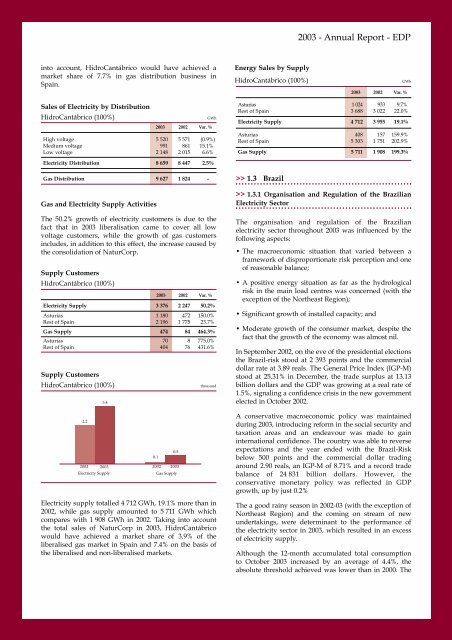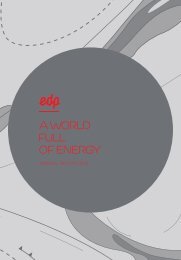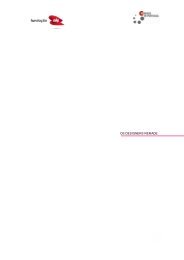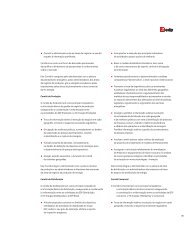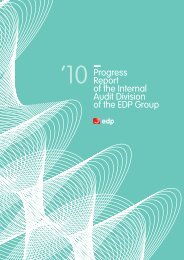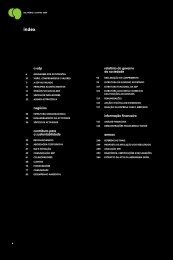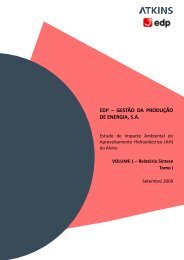business plan for 2004 - EDP
business plan for 2004 - EDP
business plan for 2004 - EDP
Create successful ePaper yourself
Turn your PDF publications into a flip-book with our unique Google optimized e-Paper software.
into account, HidroCantábrico would have achieved a<br />
market share of 7.7% in gas distribution <strong>business</strong> in<br />
Spain.<br />
Sales of Electricity by Distribution<br />
HidroCantábrico (100%) GWh<br />
Gas and Electricity Supply Activities<br />
2003 2002 Var. %<br />
High voltage 5 520 5 571 (0.9%)<br />
Medium voltage 991 861 15.1%<br />
Low voltage 2 148 2 015 6.6%<br />
Electricity Distribution 8 659 8 447 2.5%<br />
Gas Distribution 9 627 1 824 -<br />
The 50.2% growth of electricity customers is due to the<br />
fact that in 2003 liberalisation came to cover all low<br />
voltage customers, while the growth of gas customers<br />
includes, in addition to this effect, the increase caused by<br />
the consolidation of NaturCorp.<br />
Supply Customers<br />
HidroCantábrico (100%)<br />
2003 2002 Var. %<br />
Electricity Supply 3 376 2 247 50.2%<br />
Asturias 1 180 472 150.0%<br />
Rest of Spain 2 196 1 775 23.7%<br />
Gas Supply 474 84 464.3%<br />
Asturias 70 8 775.0%<br />
Rest of Spain 404 76 431.6%<br />
Supply Customers<br />
HidroCantábrico (100%) thousand<br />
Electricity Supply Gas Supply<br />
Electricity supply totalled 4 712 GWh, 19.1% more than in<br />
2002, while gas supply amounted to 5 711 GWh which<br />
compares with 1 908 GWh in 2002. Taking into account<br />
the total sales of NaturCorp in 2003, HidroCantábrico<br />
would have achieved a market share of 3.9% of the<br />
liberalised gas market in Spain and 7.4% on the basis of<br />
the liberalised and non-liberalised markets.<br />
>> 1.3 Brazil<br />
2003 - Annual Report - <strong>EDP</strong><br />
Energy Sales by Supply<br />
HidroCantábrico (100%) GWh<br />
>> 1.3.1 Organisation and Regulation of the Brazilian<br />
Electricity Sector<br />
The organisation and regulation of the Brazilian<br />
electricity sector throughout 2003 was influenced by the<br />
following aspects:<br />
• The macroeconomic situation that varied between a<br />
framework of disproportionate risk perception and one<br />
of reasonable balance;<br />
• A positive energy situation as far as the hydrological<br />
risk in the main load centres was concerned (with the<br />
exception of the Northeast Region);<br />
• Significant growth of installed capacity; and<br />
2003 2002 Var. %<br />
Asturias 1 024 933 9.7%<br />
Rest of Spain 3 688 3 022 22.0%<br />
Electricity Supply 4 712 3 955 19.1%<br />
Asturias 408 157 159.9%<br />
Rest of Spain 5 303 1 751 202.9%<br />
Gas Supply 5 711 1 908 199.3%<br />
• Moderate growth of the consumer market, despite the<br />
fact that the growth of the economy was almost nil.<br />
In September 2002, on the eve of the presidential elections<br />
the Brazil-risk stood at 2 393 points and the commercial<br />
dollar rate at 3.89 reals. The General Price Index (IGP-M)<br />
stood at 25.31% in December, the trade surplus at 13.13<br />
billion dollars and the GDP was growing at a real rate of<br />
1.5%, signaling a confidence crisis in the new government<br />
elected in October 2002.<br />
A conservative macroeconomic policy was maintained<br />
during 2003, introducing re<strong>for</strong>m in the social security and<br />
taxation areas and an endeavour was made to gain<br />
international confidence. The country was able to reverse<br />
expectations and the year ended with the Brazil-Risk<br />
below 500 points and the commercial dollar trading<br />
around 2.90 reals, an IGP-M of 8.71% and a record trade<br />
balance of 24 831 billion dollars. However, the<br />
conservative monetary policy was reflected in GDP<br />
growth, up by just 0.2%<br />
The a good rainy season in 2002-03 (with the exception of<br />
Northeast Region) and the coming on stream of new<br />
undertakings, were determinant to the per<strong>for</strong>mance of<br />
the electricity sector in 2003, which resulted in an excess<br />
of electricity supply.<br />
Although the 12-month accumulated total consumption<br />
to October 2003 increased by an average of 4.4%, the<br />
absolute threshold achieved was lower than in 2000. The


